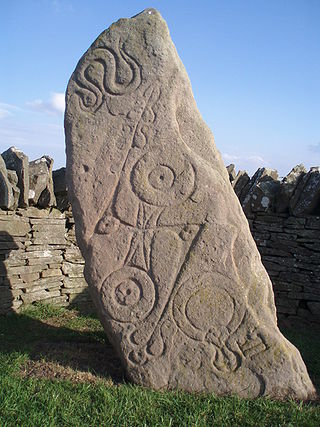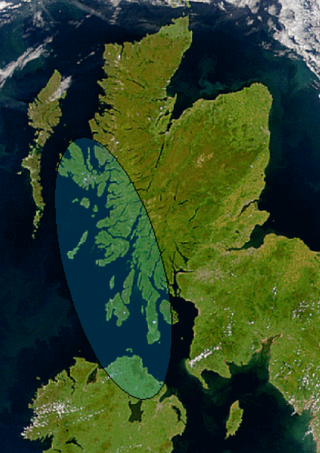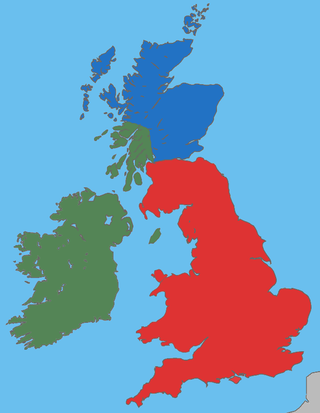Language classification

The existence of a distinct Pictish language during the Early Middle Ages is attested clearly in Bede's early eighth-century Ecclesiastical History of the English People , which names Pictish as a language distinct from those spoken by the Britons, the Irish, and the English. [3] Bede states that Columba, a Gael, used an interpreter during his mission to the Picts. A number of competing theories have been advanced regarding the nature of the Pictish language:
- Pictish was an insular Celtic language allied to the P-Celtic language Brittonic (descendants Welsh, Cornish, Cumbric, and Breton).
- Pictish was an insular Celtic language allied to the Q-Celtic (Goidelic) languages (Irish, Scottish Gaelic, and Manx).
- Pictish was one of the Pre-Indo-European languages, a relic of the Bronze Age.
Most modern scholars agree that the ancestor of the Pictish language, spoken at the time of the Roman conquest, was a branch of the Brittonic language, while a few scholars accept that it was merely "related" to the Brittonic language. [4] [5] [6] Pictish came under increasing influence from the Goidelic language spoken in Dál Riata from the eighth century until its eventual replacement. [4] [7] [5] [6]
Pictish is thought to have influenced the development of modern Scottish Gaelic. This is perhaps most obvious in the contribution of loan words, but, more importantly, Pictish is thought to have influenced the syntax of Scottish Gaelic, which is more similar to Brittonic languages than to Irish. [4] [7] [8]
Position within Celtic
The evidence of place names and personal names demonstrates that an insular Celtic language related to the more southerly Brittonic languages was formerly spoken in the Pictish area. [9] The view of Pictish as a P-Celtic language was first proposed in 1582 by George Buchanan, who aligned the language with Gaulish. [10] A compatible view was advanced by antiquarian George Chalmers in the early 19th century. Chalmers considered that Pictish and Brittonic were one and the same, basing his argument on P-Celtic orthography in the Pictish king lists and in place names predominant in historically Pictish areas. [11]
Although demonstrably Celtic-speaking, the exact linguistic affinity of the Roman-era predecessors to the Picts is difficult to securely establish. The personal name Vepogeni, recorded c. 230 AD, implies that P-Celtic was spoken by at least the Caledonians. [12]

Celtic scholar Whitley Stokes, in a philological study of the Irish annals, concluded that Pictish was closely related to Welsh. [14] This conclusion was supported by philologist Alexander MacBain's analysis of the place and tribe names in Ptolemy's second-century Geographia . [15] Toponymist William Watson's exhaustive review of Scottish place names demonstrated convincingly the existence of a dominant P-Celtic language in historically Pictish areas, concluding that the Pictish language was a northern extension of British and that Gaelic was a later introduction from Ireland. [16]
William Forbes Skene argued in 1837 that Pictish was a Goidelic language, the ancestor of modern Scottish Gaelic. [17] [18] He suggested that Columba's use of an interpreter reflected his preaching to the Picts in Latin, rather than any difference between the Irish and Pictish languages. [19] This view, involving independent settlement of Ireland and Scotland by Goidelic people, obviated an Irish influence in the development of Gaelic Scotland and enjoyed wide popular acceptance in 19th-century Scotland. [20] [21]
Skene later revised his view of Pictish, noting that it appeared to share elements of both Goidelic and Brittonic:
It has been too much narrowed by the assumption that, if it is shewn to be a Celtic dialect, it must of necessity be absolutely identic in all its features either with Welsh or with Gaelic. But this necessity does not really exist; and the result I come to is, that it is not Welsh, neither is it Gaelic; but it is a Gaelic dialect partaking largely of Welsh forms. [22]
The Picts were under increasing political, social, and linguistic influence from Dál Riata from around the eighth century. The Picts were steadily gaelicised through the latter centuries of the Pictish kingdom, and by the time of the merging of the Pictish and Dál Riatan kingdoms, the Picts were essentially a Gaelic-speaking people. [4] Forsyth speculates that a period of bilingualism may have outlasted the Pictish kingdom in peripheral areas by several generations. [23] Scottish Gaelic, unlike Irish, maintains a substantial corpus of Brittonic loan-words and, moreover, uses a verbal system modelled on the same pattern as Welsh. [24]
The traditional Q-Celtic vs P-Celtic model, involving separate migrations of P-Celtic and Q-Celtic speaking settlers into the British Isles, is one of mutual unintelligibility, with the Irish Sea serving as the frontier between the two. However, it is likely that the Insular Celtic languages evolved from a more-or-less unified proto-Celtic language within the British Isles. [25] Divergence between P-Celtic Pictish and Q-Celtic Dalriadan Goidelic was slight enough to allow Picts and Dalriadans to understand each other's language to some degree. [7] [26] Under this scenario, a gradual linguistic convergence is conceivable and even probable given the presence of the Columban Church in Pictland. [7]
Pre-Indo-European hypothesis

In 1892, John Rhys proposed that Pictish was a non-Indo-European language. This opinion was based on the apparently unintelligible ogham inscriptions found in historically Pictish areas (compare Ogham inscription § Scholastic inscriptions). [27] A similar position was taken by Heinrich Zimmer, who argued that the Picts' supposedly exotic cultural practices (tattooing and matriliny) were equally non-Indo-European, [28] and a pre-Indo-European model was maintained by some well into the 20th century. [29]
A modified version of this theory was advanced in an influential 1955 review of Pictish by Kenneth Jackson, who proposed a two-language model: while Pictish was undoubtedly P-Celtic, it may have had a non-Celtic substratum and a second language may have been used for inscriptions. [30] Jackson's hypothesis was framed in the then-current model that a Brittonic elite, identified as the Broch-builders, had migrated from the south of Britain into Pictish territory, dominating a pre-Celtic majority. [31] He used this to reconcile the perceived translational difficulties of Ogham with the overwhelming evidence for a P-Celtic Pictish language. Jackson was content to write off Ogham inscriptions as inherently unintelligible. [32]
Jackson's model became the orthodox position for the latter half of the 20th century. However, it became progressively undermined by advances in understanding of late Iron Age archaeology. [33] Celtic interpretations have been suggested for a number of Ogham inscriptions in recent years, though this remains a matter of debate. [34]
Other discredited theories
Traditional accounts (now rejected) claimed that the Picts had migrated to Scotland from Scythia, a region that encompassed Eastern Europe and Central Asia. [35] Buchanan, looking for a Scythian P-Celtic candidate for the ancestral Pict, settled on the Gaulish-speaking Cotini (which he rendered as Gothuni), a tribe from the region that is now Slovakia. This was later misunderstood by Robert Sibbald in 1710, who equated Gothuni with the Germanic-speaking Goths . [36] John Pinkerton expanded on this in 1789, claiming that Pictish was the predecessor to modern Scots. [37] Pinkerton's arguments were often rambling, bizarre and clearly motivated by his belief that Celts were an inferior people. The theory of a Germanic Pictish language is no longer considered credible. [38]














